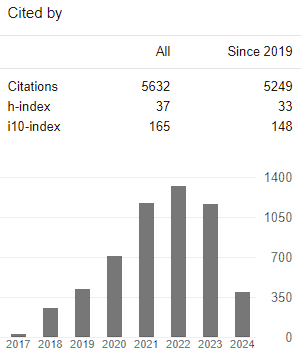Gini ratio analysis in North Buton Regency
Keywords:
differences in production factors, distribution pattern, economic growth, income distribution, inequalityAbstract
This research was carried out in North Buton Regency in 2020. The purpose of this study was to determine the income inequality of the community both between the Regency and the District and between the District and the District and the variables that cause income inequality in the North Buton Regency. The results of the Gini Ratio analysis show that the income distribution of the people of North Buton Regency is relatively unequal with a Gini coefficient value of 0.36. Districts with low-income inequality (a) West Kulisusu District with a Gini coefficient of 0.24 (b) and Bonegunu District with a Gini coefficient of 0.29. Having moderate-income inequality (a) Kulisusu sub-district with a Gini coefficient of 0.32. (b) Wakorumba sub-district with a Gini coefficient of 0.32 and (c) Kambowa District with a Gini coefficient of 0.37. Meanwhile, sub-districts that have high-income inequality (a) North Kulisusu sub-district have a Gini coefficient of 0.43. The main variables that cause income inequality in North Buton Regency are differences in natural resource potential, differences in community skills and work ethic, differences in ownership of production factors, differences in regional accessibility, differences in community livelihoods, and government and private investment.
Downloads
References
Adelman, I., & Chenery, H. B. (1966). The foreign aid and economic development: the case of Greece. The Review of Economics and Statistics, 1-19.
Adisasmita, R. (2006). Pembangunan kelautan dan kewilayahan. Graha Ilmu.
Ardagna, S. (2001). Fiscal policy composition, public debt, and economic activity. Public Choice, 109(3), 301-325.
Bento, A. C. (2018). IoT of Nextion X TFT ILI9341: Experimental Results and Comparative Survey. International Research Journal of Engineering, IT and Scientific Research, 4(2), 14-23.
Brooks, D. H., Fan, E. X., & Sumulong, L. R. (2003). Foreign direct investment in developing Asia: trends, effects, and likely issues for the forthcoming WTO negotiations.
Brown, M. C. (1994). Using Gini-style indices to evaluate the spatial patterns of health practitioners: theoretical considerations and an application based on Alberta data. Social science & medicine, 38(9), 1243-1256. https://doi.org/10.1016/0277-9536(94)90189-9
Budiharsono, S. (1989). Perencanaan Pembangunan Wilayah: Teori, Model Perencanaan dan Penerapannya. Bappenas, Jakarta.
Cassimon, D., & Van Campenhout, B. (2007). Aid effectiveness, debt relief and public finance response: evidence from a panel of HIPC countries. Review of world economics, 143(4), 742-763.
Chen, J., Wu, Y., Wen, J., Cheng, S., & Wang, J. (2017). Regional differences in China's fossil energy consumption: an analysis for the period 1997–2013. Journal of cleaner production, 142, 578-588. https://doi.org/10.1016/j.jclepro.2016.05.135
Choe, J. (2008). Income inequality and crime in the United States. Economics Letters, 101(1), 31-33. https://doi.org/10.1016/j.econlet.2008.03.025
Dagum, C. (1990). On the relationship between income inequality measures and social welfare functions. Journal of Econometrics, 43(1-2), 91-102. https://doi.org/10.1016/0304-4076(90)90109-7
Di Castelnuovo, A., Costanzo, S., Antinori, A., Berselli, N., Blandi, L., Bruno, R., ... & Iacoviello, L. (2020). Use of hydroxychloroquine in hospitalised COVID-19 patients is associated with reduced mortality: Findings from the observational multicentre Italian CORIST study. European Journal of Internal Medicine, 82, 38-47. https://doi.org/10.1016/j.ejim.2020.08.019
Eisenberg, B. (2015). The multivariate Gini ratio. Statistics & Probability Letters, 96, 292-298. https://doi.org/10.1016/j.spl.2014.10.009
Farinelli, S., Ferreira, M., Rossello, D., Thoeny, M., & Tibiletti, L. (2008). Beyond Sharpe ratio: Optimal asset allocation using different performance ratios. Journal of Banking & Finance, 32(10), 2057-2063. https://doi.org/10.1016/j.jbankfin.2007.12.026
Fernandez-Morales, A. (2003). Decomposing seasonal concentration. Annals of Tourism Research, 30(4), 942-956. https://doi.org/10.1016/S0160-7383(03)00090-2
Friedmann, J., & Alonso, W. (1964). Regional development and planning. A reader. Regional development and planning. A reader.
García-Peñalosa, C., & Turnovsky, S. J. (2005). Production risk and the functional distribution of income in a developing economy: tradeoffs and policy responses. Journal of Development Economics, 76(1), 175-208.
Kemiskinan, B. K. P. (2004). Strategi Nasional Penanggulangan Kemiskinan. Jakarta: Bappenas.
King, R. G., & Levine, R. (1994, June). Capital fundamentalism, economic development, and economic growth. In Carnegie-Rochester Conference Series on Public Policy (Vol. 40, pp. 259-292). North-Holland.
Lerman, R. I., & Yitzhaki, S. (1984). A note on the calculation and interpretation of the Gini index. Economics Letters, 15(3-4), 363-368. https://doi.org/10.1016/0165-1765(84)90126-5
Manurung, R. (2009). Defisit APBN dan ketahanan fiskal. Jurnal Ekonomi dan Pembangunan, 17(2), 1-15.
Torras, M., & Boyce, J. K. (1998). Income, inequality, and pollution: a reassessment of the environmental Kuznets curve. Ecological economics, 25(2), 147-160. https://doi.org/10.1016/S0921-8009(97)00177-8
Published
How to Cite
Issue
Section
Copyright (c) 2021 International research journal of management, IT and social sciences

This work is licensed under a Creative Commons Attribution-NonCommercial-NoDerivatives 4.0 International License.
Articles published in the International Research Journal of Management, IT and Social sciences (IRJMIS) are available under Creative Commons Attribution Non-Commercial No Derivatives Licence (CC BY-NC-ND 4.0). Authors retain copyright in their work and grant IRJMIS right of first publication under CC BY-NC-ND 4.0. Users have the right to read, download, copy, distribute, print, search, or link to the full texts of articles in this journal, and to use them for any other lawful purpose.
Articles published in IRJMIS can be copied, communicated and shared in their published form for non-commercial purposes provided full attribution is given to the author and the journal. Authors are able to enter into separate, additional contractual arrangements for the non-exclusive distribution of the journal's published version of the work (e.g., post it to an institutional repository or publish it in a book), with an acknowledgment of its initial publication in this journal.
This copyright notice applies to articles published in IRJMIS volumes 7 onwards. Please read about the copyright notices for previous volumes under Journal History.

















